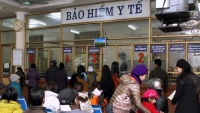
Foreign labour could be put off by Vietnam’s social insurance policy
Latest
| TIN LIÊN QUAN | |
| Vietnam, Argentina forge stronger collaboration | |
| Vietnam’s labour productivity increases in 5 years | |
According to the Vietnam Business Forum 2018 (VBF 2018) investment and trade working group, the social insurance contribution rates that have been imposed on both foreign employees and their employers under Decree No. 143/2018/ND-CP, will be the same as those applicable to Vietnamese employees. For instance, 8 percent from employees and 17.5 percent from employers.
The contribution rates are based on the salary used to calculate compulsory social insurance which is capped at 20 times the applicable general minimum salary as prescribed by the Government.
The working group, led by Mr. Fred Burke, claimed that investors, both foreign and domestic, are concerned that the rapidly rising cost of labour may undermine Vietnam's attractiveness as an investment destination. It may also impact on the Government's ability to continue generating jobs for young people.
Between December 1 2018 and December 31 2021, companies who have foreign employees must pay the 3.5 percent ratio, including 3 percent for their health fund and 0.5 percent for the accident and occupational disease fund. Meanwhile, foreign employees themselves are not applicable in the reviewed period.
 |
| Social insurance contributions may deter employers from using foreign labour and bringing further overseas talent to Vietnam, said EUROCHAM. |
From January 1 2022 onwards, the contribution set for employers rises to 17.5 percent, while employees are subject to 8 percent for their retirement fund.
The working group noted that when applying these figures, from January 1 2022 onwards, a combined contribution of US$326.6 for an employee with wages of US$4,000 per month will be considered a burden by many, especially if there are any issues with redemption, pay-out and remittance at the end of the contract period.
These contributions would make Vietnam's taxes on workers among the highest in the region, taking into account the number of taxes, high rates, and broad bases (which include not only salary but other forms of benefits).
The European Chamber of Commerce in Vietnam, stated in a position paper for the VBF 2018 that the statutory social insurance contributions may deter employers from using foreign labour, and bringing overseas talent to Vietnam, who in turn could train and assist in the development of the Vietnamese labour force.
These contributions will also represent a significant cost for businesses employing large numbers of foreign workers which are essential to Vietnam’s strategy for development, such as educational and technology institutions.
Meanwhile, the VBF 2018 human resources working group expected the double taxation of foreigners would not occur as they are already required to participate in social security schemes in their home countries and also pay Vietnamese social security at the same time.
“We are willing to assist, however we can in facilitating country-by-country agreements avoid double taxation”, the group said.
The long-awaited Decree No. 143/2018/ND-CP providing detailed guidance on compulsory social insurance applicable to foreign employees working in Vietnam was issued on October 15 and came into effect from December 1 onwards.
 | Over 81% of Vietnamese population covered by health insurance Some 81.3 million people across Vietnam have been covered by health insurance by the end of May, up nearly 21 million people from 2012 or ... |
 | Over 80,000 foreigners working in Vietnam Vietnam is now home to more than 80,000 foreign workers, according to Le Quang Trung, deputy head of the Department of Employment under the Ministry ... |
 | Dai-ichi Life Insurance becomes first Japanese financial institution to restrict coal support Japanese financial institution takes first step towards divestment from coal. |

















